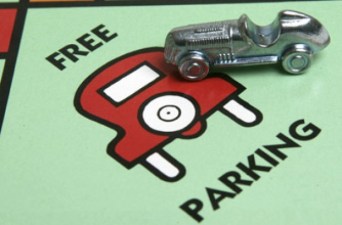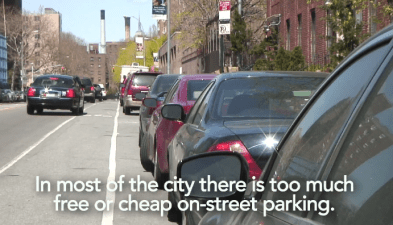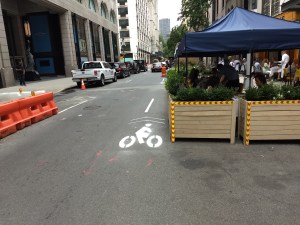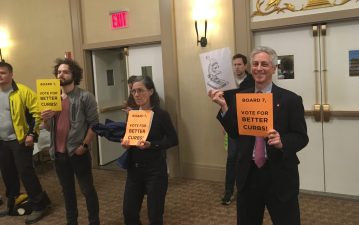KOMANOFF: Congestion Pricing Will NOT Fill Upper Manhattan With Suburbanites Cruising for Parking

This just in, from Karl Marx: A spectre is haunting the edges of the Manhattan charging zone — the spectre of car commuters from Westchester and Long Island appropriating on-street parking spaces and hopping on trains to the Manhattan core.
What is to be done? cried Engels. Must our electeds cave to the parking hoarders and stop congestion pricing?
Marx: No, never. Not when we can fire up the Balanced Transportation Analyzer spreadsheet and see how few CBD-bound drivers will find it in their interest to park on a street on the Upper West Side or in Bedford-Stuyvesant to avoid the congestion toll.
Closet commie that I am, that’s what I did. I asked the BTA, and the answer came back: around a thousand — 1,100, actually. That’s my estimate of how many drivers of private autos entering the central business district between 6-10 a.m. on a weekday will be motivated by the toll to become park-and-riders.
Is 1,100 a lot? Maybe to an obsessive — the type whose reaction to the dropping of the atomic bomb would have been, Is it good for alternate-side-of-the-street parking? Seriously, the import of the figure is for others to decide. I’ll limit the rest of this post to explaining how I derived it.
I started by establishing the size of the “pool” — the number of private autos currently driven into the Manhattan Central Business District from outside, during prime weekday commuting hours, 6 to 10 a.m. That figure is just 109,000. If it seems small, consider what it purposely omits: trucks (which need to access the CBD, obviously); cabs and Ubers (ditto); vehicles that pass through Manhattan (for which park-and-ride is infeasible); and vehicle trips outside morning peak hours (when competition for neighborhood parking is less cutthroat and, thus, not a pressing public concern).
Next, I estimated the share of those trips that the congestion toll would “tip” into parking outside the CBD. That calculation has a surprising number of parts — the new toll to skirt, parking costs in the CBD avoided by remaining outside, subway fares to pay, the time spent finding on-street parking on the outskirts, time saved by not driving all the way in but now incurred on the train, and the hassle factor of leaving the car on the street somewhere. That made for a kaleidoscope of parameters that cried out for quantification by my BTA spreadsheet (downloadable Excel spreadsheet).
I structured the calculation probabilistically. I first calculated the percentage of those 109,000 trips that now (without congestion pricing) appear to be less expensive to park-and-ride than drive all the way. Then I added the congestion charge, a peak toll of $12.24, matching the TBTA’s round-trip bridge and tunnel tolls set to take effect at the end of March. I also inputted the speedier car commute from congestion pricing (but not speedier subways on account of the time lag in investing congestion revenues into service improvements), along with an expected 10 percent drop in CBD parking costs due to the fall in commuting volume. And of course I imputed a value of time, around $28/hr, to apply to the travel time gained and lost by switching parking destinations.
My inputs and outputs are on display in the BTA’s “Park-and-Ride” tab. They yield a mere 1 percentage point rise in the likelihood that a peak-hour CBD-bound car commuter will abandon the “it’s cheaper to drive all the way” camp and join “the toll has made it cheaper for me to park outside” camp. (The calculated figure is 2 percent, but I cut that in half to eliminate the CBD-bound morning drivers who don’t pay out of their own pocket to park in Manhattan.) One percent of the 109,000 eligible drivers (rounded) is of course 1,100; that’s how many CBD-bound morning drivers will venture to park on an outlying street and complete their journey via train, on account of congestion pricing.
This conclusion isn’t exactly novel. A study by West Harlem Environmental Action over a decade ago (the Northern Manhattan and the Congestion Pricing Plan) produced a similar result. If that didn’t settle the park-and-ride issue, I certainly don’t expect my analysis to do so.
Indeed, we’re probably past the point — if there ever was one — where reasoned analysis can move the congestion pricing debate. As you read this, legislators are frantically figuring their electoral prospects, not how many minutes a day and hours a year congestion pricing may save their constituents on the trains, in buses and in their cars.
Nevertheless, free parking spaces are totemic in New York politics, and some politicians take the spectre of 50,000 invading space-seeking drivers more to heart than the reality of millions plagued by delayed trains, stuck buses and snarled streets. Cutting the spectre down to size might be one of those things that can push congestion pricing across the finish line next week.



